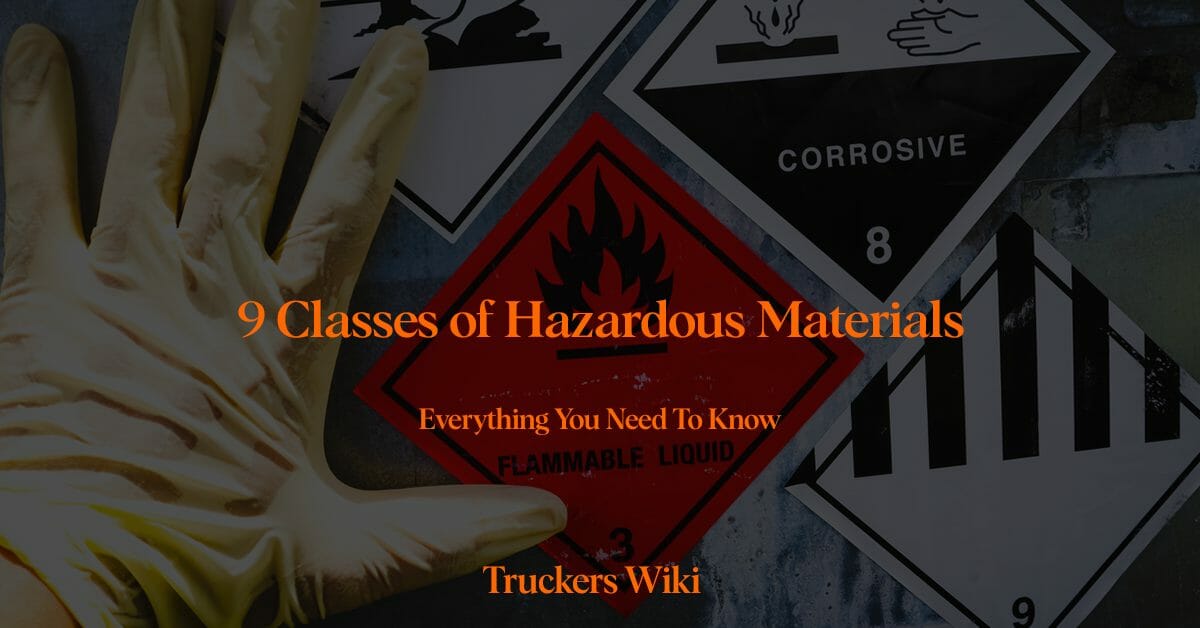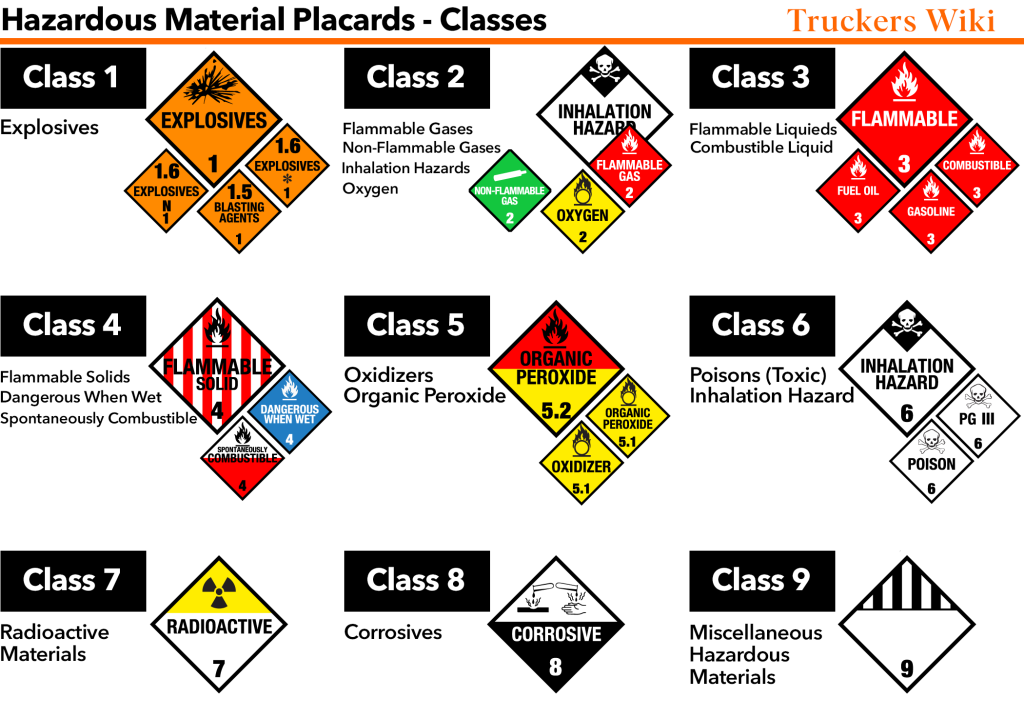
Table of Contents
What are the 9 Classes of Hazardous Materials in Trucking
Hazardous materials demand specific attention due to their potential risks to public safety, the environment, and the transporters themselves.
The U.S. Department of Transportation (D-O-T) has defined nine classes of hazardous materials based on their inherent risks. It’s imperative for everyone involved in the process of their transportation to possess a thorough understanding of these classifications to ensure safety, regulatory compliance, and efficient transportation.
These are the 9 classes of hazardous materials as per FMCSA.
The 9 Hazardous Materials Classes
Class 1: Explosives
Explosive materials have the ability to rapidly detonate or deflagrate under certain conditions. They’re subdivided into:
- 1.1: Substances with a mass explosion hazard.
- 1.2: Substances with a projection hazard but not a mass explosion hazard.
- 1.3: Substances with a fire and minor blast or projection hazard.
- 1.4: Substances presenting only a minor explosion hazard.
- 1.5: Very insensitive substances with a mass explosion hazard.
- 1.6: Extremely insensitive substances with no mass explosion hazard.
Class 2: Gases
Gases can pose various threats, from flammability to toxicity:
- 2.1 Flammable Gases: Gases which can ignite, like propane or hydrogen.
- 2.2 Non-Flammable Gases: Gases which don’t burn, such as nitrogen or carbon dioxide.
- 2.3 Toxic Gases: Gases harmful when inhaled, like chlorine.
Class 3: Flammable and Combustible Liquids
These liquids are characterized by their flash points:
- Flammable Liquids: Have a flash point of not more than 60°C (140°F).
- Combustible Liquids: Have a flash point above 60°C (140°F) but below 93°C (200°F).
Class 4: Flammable Solids
- 4.1 Flammable Solids: Substances that can easily ignite, such as magnesium or sulfur.
- 4.2 Spontaneously Combustible: Materials that can spontaneously heat and ignite in air, like certain types of coal.
- 4.3 Dangerous When Wet: Substances that emit flammable gases when in contact with water, such as sodium.
Class 5: Oxidizing Substances and Organic Peroxides
- 5.1 Oxidizing Substances: Materials that can yield oxygen to stimulate the combustion of organic matter.
- 5.2 Organic Peroxides: Often used for making plastics and rubber, they can burn rapidly and are sensitive to impact or temperature changes.
Class 6: Toxic and Infectious Substances
- 6.1 Toxic Substances: Can cause harm to human health, either by inhalation, ingestion, or skin absorption.
- 6.2 Infectious Substances: Contains pathogens that can cause diseases in living organisms.
Class 7: Radioactive Materials
Materials that emit ionizing radiation. They’re categorized by specific activity and transport index, and their handling requires specialized training and equipment.
Class 8: Corrosives
These are substances that, through chemical action, can damage or even destroy living tissues and other materials upon contact. Examples include battery acid and strong bases like lye.
Class 9: Miscellaneous Dangerous Goods
This is a catch-all category for hazardous materials that don’t fit precisely into the other eight classes. It includes:
- Environmentally Hazardous Substances: Can pose a risk if released into the environment.
- Elevated Temperature Substances: Transported in a liquid state at temperatures above 100°C.
Insurance and CDL Certification for Hazardous Materials
Transporting hazardous materials comes with added responsibilities, which, in turn, necessitate specific certifications and insurance coverages:
CDL Endorsement: To transport hazardous materials, truckers need a Commercial Driver’s License (CDL) with a Hazardous Materials (H) endorsement. Obtaining this endorsement requires passing a written test and undergoing a TSA background check.
Learn about H Endorsement here.Insurance Requirements: Due to the increased risks associated with transporting hazardous materials, carriers often require higher liability insurance coverage. The specifics can vary based on the material’s class and quantity, but it’s not uncommon for requirements to be $1 million or more.
External Links
9 Classes of Hazardous Material – FMCSA.
Nine Classes of Hazardous Materials (Yellow Visor Card) – FMCSA
Listen to The Article Here
9 Classes of Dangerous Freight

Audio Article Nine Classes of Hazardous Materials What are the
Last modified: January 4, 2024

